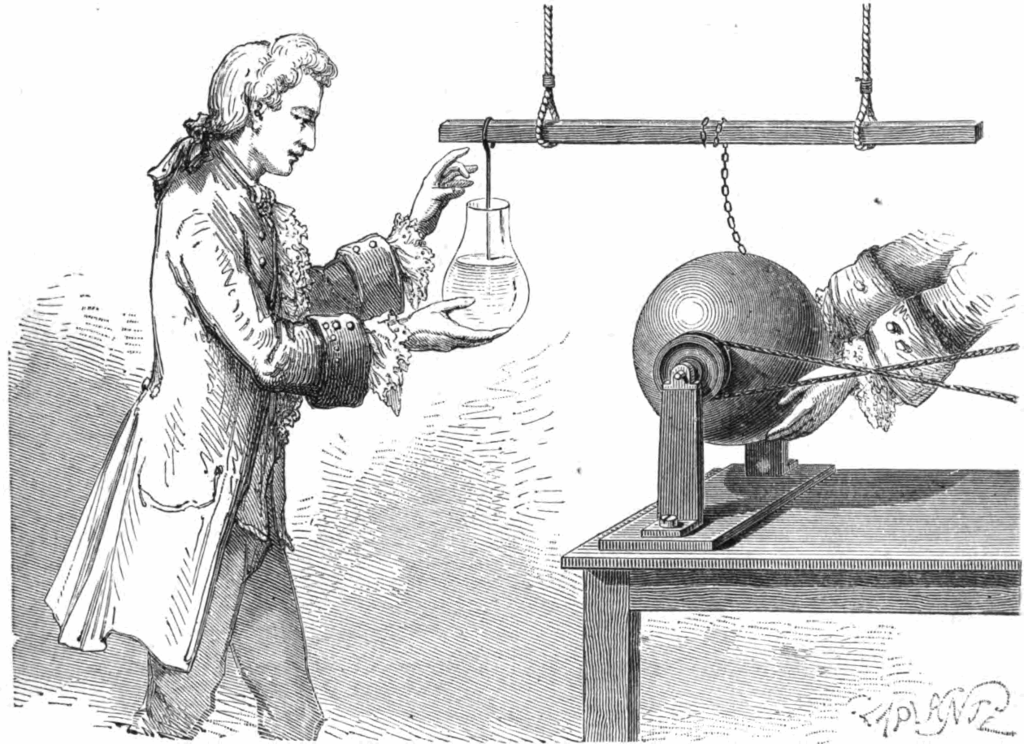Leyden Jar
Capacitance
Victoria Falls
Prov. 24:21
"My son, fear thou the LORD and the king: and meddle not with them that are given to change:"
Prov. 28:4
"They that forsake the law praise the wicked: but such as keep the law contend with them."
Eccles. 1:4
"One generation passeth away, and [another] generation cometh: but the earth abideth for ever."
Microlight
A microlight will tour gives an unbeatable tour of Victoria Falls.
Victoria Falls, Zimbabwe
Electromagnetism
Discovery of the Leyden jar in Musschenbroek's lab. The static electricity produced by the rotating glass sphere electrostatic generator was conducted by the chain through the suspended bar to the water in the glass held by assistant Andreas Cuneus. A large charge accumulated in the water and an opposite charge in Cuneus' hand on the glass. When he touched the wire dipping in the water, he received a powerful shock.
“Palmito” “Heart of Palm” “South Carolina” “Circumcision”; Pacífico : “Nicoya” “Jacó” “Golfito” “EL Callao” ; Miller: "The Miller's Tale" “Steve Miller Band” Jer. 4:4 “Circumcise yourselves to the Lord”
--> -->Xul Solar” “Great Pyramid:Circumcision” : “Drink itself does not seem to elevate him” [Lamb (“Circumcision”)]
Capacitance :
Capacitance is the ability of a body to store an electrical charge. Any object that can be electrically charged exhibits capacitance. A common form of energy storage device is a parallel-plate capacitor. In a parallel plate capacitor, capacitance is directly proportional to the surface area of the conductor plates and inversely proportional to the separation distance between the plates. If the charges on the plates are +q and −q respectively, and V gives the voltage between the plates, then the capacitance C is given by
The SI unit of capacitance is the farad (symbol: F), named after the English physicist Michael Faraday. A 1 farad capacitor, when charged with 1 coulomb of electrical charge, has a potential difference of 1 volt between its plates.[1] Historically, a farad was regarded as an inconveniently large unit, both electrically and physically. Its subdivisions were invariably used, namely the microfarad, nanofarad and picofarad. More recently, technology has advanced such that capacitors of 1 farad and greater can be constructed in a structure little larger than a coin battery (so-called 'supercapacitors'). Such capacitors are principally used for energy storage replacing more traditional batteries.
The energy (measured in joules) stored in a capacitor is equal to the work done to charge it. Consider a capacitor of capacitance C, holding a charge +q on one plate and −q on the other. Moving a small element of charge dq from one plate to the other against the potential difference V = q/C requires the work dW:
The energy stored in a capacitor is found by integrating this equation. Starting with an uncharged capacitance (q = 0) and moving charge from one plate to the other until the plates have charge +Q and −Q requires the work W:
EDIPO Y EL ENIGMA
Cuadrúpedo en la aurora, alto en el día
y con tres pies errando por el vano
ámbito de la tarde, así veía
la eterna esfinge a su inconstante hermano,
el hombre, y con la tarde un hombre vino
que descifró aterrado en el espejo
de la monstruosa imagen, el reflejo
de su declinación y su destino.
Somos Edipo y de un eterno modo
la larga y triple bestia somos, todo
lo que seremos y lo que hemos sido.
Nos aniquilaría ver la ingente
forma de nuestro ser; piadosamente
Dios nos depara sucesión y olvido.
y con tres pies errando por el vano
ámbito de la tarde, así veía
la eterna esfinge a su inconstante hermano,
el hombre, y con la tarde un hombre vino
que descifró aterrado en el espejo
de la monstruosa imagen, el reflejo
de su declinación y su destino.
Somos Edipo y de un eterno modo
la larga y triple bestia somos, todo
lo que seremos y lo que hemos sido.
Nos aniquilaría ver la ingente
forma de nuestro ser; piadosamente
Dios nos depara sucesión y olvido.
Jorge Luis Borges
|








No comments:
Post a Comment